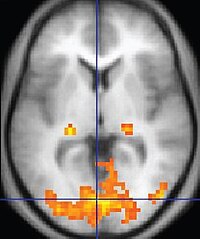
Photo from wikipedia
Background Enhancing lesions on MRI scans obtained after contrast material administration are commonly thought to represent disease activity in multiple sclerosis (MS); it is desirable to develop methods that can… Click to show full abstract
Background Enhancing lesions on MRI scans obtained after contrast material administration are commonly thought to represent disease activity in multiple sclerosis (MS); it is desirable to develop methods that can predict enhancing lesions without the use of contrast material. Purpose To evaluate whether deep learning can predict enhancing lesions on MRI scans obtained without the use of contrast material. Materials and Methods This study involved prospective analysis of existing MRI data. A convolutional neural network was used for classification of enhancing lesions on unenhanced MRI scans. This classification was performed for each slice, and the slice scores were combined by using a fully connected network to produce participant-wise predictions. The network input consisted of 1970 multiparametric MRI scans from 1008 patients recruited from 2005 to 2009. Enhanced lesions on postcontrast T1-weighted images served as the ground truth. The network performance was assessed by using fivefold cross-validation. Statistical analysis of the network performance included calculation of lesion detection rates and areas under the receiver operating characteristic curve (AUCs). Results MRI scans from 1008 participants (mean age, 37.7 years ± 9.7; 730 women) were analyzed. At least one enhancing lesion was observed in 519 participants. The sensitivity and specificity averaged across the five test sets were 78% ± 4.3 and 73% ± 2.7, respectively, for slice-wise prediction. The corresponding participant-wise values were 72% ± 9.0 and 70% ± 6.3. The diagnostic performances (AUCs) were 0.82 ± 0.02 and 0.75 ± 0.03 for slice-wise and participant-wise enhancement prediction, respectively. Conclusion Deep learning used with conventional MRI identified enhanced lesions in multiple sclerosis from images from unenhanced multiparametric MRI with moderate to high accuracy. © RSNA, 2019.
Journal Title: Radiology
Year Published: 2019
Link to full text (if available)
Share on Social Media: Sign Up to like & get
recommendations!